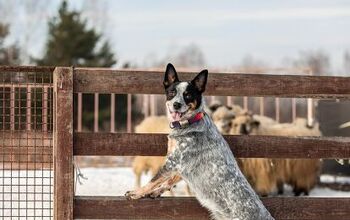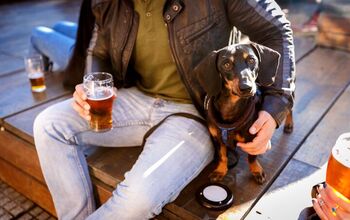Why is Mental Enrichment Important for My Dog?

While physical exercise and a balanced diet are essential elements of a healthy, happy life for your dog, there’s another aspect of their well-being that often goes unnoticed – mental enrichment. Like us, our dogs require mental stimulation to lead fulfilling lives and avoid unnecessary boredom. But you may be asking, why is mental enrichment important for my dog?
In this article, we will look at the different types of enrichment dogs need for a balanced, happy life and how you, as a devoted and loving dog parent, can meet all your dog’s needs.
What is Mental Enrichment for Dogs?
Have you ever been in a situation where you were so bored that your mind was wandering, and you thought you were going crazy? This is because your mind isn’t being challenged. It’s a struggle that your dog can experience too. The difference is that your dog can’t tell you that they are bored and need to do something to exercise their mind. Instead, we need to be proactive and incorporate mental puzzles and challenges into their daily routine to keep them entertained and occupied.
These enrichment activities tap into their instincts and innate behaviors, allowing them to engage in behaviors often discouraged as domesticated pets, like chewing, digging, chasing, scavenging, and hunting. By giving them a safe outlet for these behaviors, we allow them to fulfill their needs while also discouraging them from bad habits like chewing our shoes or digging up the garden.
Why is Mental Stimulation Important for Animals?
Exercising your dog’s mind can help improve their quality of life in several ways. First, it’s critical for preventing boredom. Many behavior issues can be traced back to a bored dog looking for ways to entertain themselves or relieve pent-up energy. Eliminate the boredom, and, in many cases, you can eliminate the problem behavior.
Another great reason to include mental stimulation in your dog’s daily routine is that it helps to keep their mind sharp. As dogs age, many will experience cognitive decline and may develop doggy dementia. The best way to slow the impact of aging on your dog’s mind is to start offering mental exercises regularly at a young age and continue it as your pup gets older.
Finally, experts have discovered that mental enrichment can wear your dog out even faster than physical activity. Have you ever heard the phrase, “A tired dog is a good dog?” By offering mental stimulation, you make it easier for your dog to settle down and relax. This is great for those dealing with issues like reactivity, stress, or separation anxiety.
What’s More Important, Physical Activity or Mental Enrichment?
The short answer is both. Your dog needs a balance of physical activity and mental enrichment daily to live a happy, healthy, fulfilled life. Luckily, there are many ways that you can incorporate both successfully in the same exercise.
Allow your dog to sniff and explore the space when walking or hiking. Often referred to as a “sniffari,” this ability to check out the sights, sounds, and smells in the environment is a great way to include mental stimulation when you’re out and about. You can also incorporate training into your outings to challenge their mind.
Many of the mental enrichment activities that I will explain below will also help get your dog up and moving.
How Much Enrichment Do Dogs Need Daily?
Now that you understand how vital mental enrichment is for your dog’s health and happiness, you may wonder if you provide enough in their current routine. The truth is that there is no hard and fast rule regarding the amount of mental and physical enrichment your dog needs each day. Instead, it varies from dog to dog. That being said, most experts say they should enjoy at least 20 minutes of active enrichment each day, plus 1-2 short walks.
If you have a lower-energy dog, that minimum requirement may be all that’s needed to keep them feeling happy and fulfilled. However, if you have a high-energy pup like our boy Lucifer, you will need to increase that to meet their needs and address all of the pent-up energy they would otherwise have.
What are the Different Types of Enrichment for Dogs?
Enrichment can be sorted into five key categories, each offering your dog a unique (and essential) outlet. The best, most balanced routines are those that find a way to include all five of these elements in their routine. Keep in mind that many activities will incorporate more than one of the following categories.
Social
This incorporates any opportunity your dog has to interact either with other dogs or other species. While most dog parents instantly think of dog parks or doggy daycares, those settings aren’t ideal for many dogs. Instead, consider focusing on supervised playdates or your interactions with your dog. This could include taking them for walks, playing with them, or simply spending quality time petting them and cuddling on the couch.
Socialization is crucial for young puppies as it allows them to experience new places, sounds, smells, and experiences. Early and well-managed socialization can help to build your dog’s confidence and prevent the development of fear, stress, or aggression when faced with something new in the future.
Nutritional
Any enrichment activities that tap into your dog’s natural desire to hunt, forage, or feed would fall into this category. Food puzzles, treat dispensing toys, and snuffle mats are all examples of nutritional enrichment, but you don’t necessarily need to break the bank to meet these needs! Try hiding treats and having your dog search for them or scattering kibble in the grass for an all-natural snuffle mat experience.
Occupational
If you research their history, each dog breed was initially created for a purpose. While some breeds were developed specifically to be companions, many had a specific job or occupation. When we fail to give our dogs a job, this natural drive to work and complete the job they were bred for goes unfulfilled.
Some options to “work” your dog if they are a pet and aren’t already working on a farm or other occupation include sports like agility, playing fetch, having them carry a doggy backpack on your hike, or training them to complete tasks around the house.
Sensory
These activities focus on stimulating your dog’s senses, including sight, sound, and smell. Many toys have been developed with this need in mind. For example, you can purchase a ball that smells like beef. When playing fetch with your dog in a large yard, they can sniff out where their ball landed, engaging that sense of smell.
You can also introduce sensory enrichment easily into your daily routine by playing soothing music, introducing pleasant dog-friendly scents into your home, or simply allowing your dog to watch wildlife or people passing by outside the front window.
Physical
Did you know that your dog’s environment also plays an essential role in their enrichment? Physical enrichment refers to the ways that your dog’s living space adds to their life. You can prioritize physical enrichment by rotating your dog’s toys so that they are always
4 Easy Ways to Include Mental Enrichment in Your Dog’s Daily Routine
As I previously mentioned, there are many products available that you can use to offer mental enrichment for your dog, including food puzzles, snuffle mats, and sensory toys. But you don’t have to break the bank to prioritize enrichment. Instead, here are four easy ways to start incorporating different forms of enrichment into your dog’s daily routine.
Make Training a Priority
Did you know that training your dog is one of the best ways to challenge their mind? If you have a pup already solid in their basic obedience commands, consider incorporating some fun tricks like teaching them how to clean up their toys or shut the door. We have currently been working on teaching Lucifer to hold a paintbrush in his mouth and paint on canvas (he’s not making any Van Gogh-worthy art yet).
Create a DIY Busy Box
Like the idea of food puzzles and snuffle mats, a DIY busy box challenges your dog to sniff out and find their food. These are easily created using items you already have at home, such as empty cardboard boxes, egg cartons, paper towel rolls, and your dog’s toys. The best part about this is the ability to make the challenge as easy or complicated as necessary for each dog.
For example, Daviana, our senior pup, is starting to lose her sight but still enjoys a slightly easier busy box with fewer obstacles. Meanwhile, we bring up the challenge level when creating one with more obstacles and puzzles for him to solve to find everything.
Scent Games
One of the great opportunities for sensory enrichment is to introduce your dog to scent work. This means hiding something recognizable and encouraging your dog to use their nose to find it. You can do this by hiding treats around your house or in a more organized fashion by creating your own scent games.
For this, you will need empty boxes or small plastic pylons. Place a high-value treat (one with a strong scent) under one box or pylon without allowing your dog to see. Then bring them into the room and tell them to “find it.” Praise your pup when they locate which box or pylon is hiding their desired treat.
If you find that your dog really enjoys scent work, as our boy Lucifer has, you can also pick up scent work kits to start working toward more formal scent work training. We have been loving The Nosey Nose, a kit that includes scent pouches and easy-to-follow instructions for training.
Hide & Seek
Here’s a childhood favorite you should consider including in your adult routine! Playing Hide & Seek with your dog is a great way to challenge their mind. Have your dog sit and stay in one room while you go and hide in another. If stay is something you are still working on with your dog, have a friend or family member prevent your dog from leaving the room until you give the okay.
When you have found your hiding spot, call your dog’s name and watch as they use their nose to search the entire room until they have found you. Be prepared to praise your dog and offer a reward when they win. This is a great way to encourage your children to play with the dog in a safe and positive way.
Final Thoughts: Mental Enrichment and Your Dog
Mental enrichment is an essential part of a happy, healthy life for your dog, but don’t overcomplicate it. Instead, find fun, simple ways to challenge your pup’s mind daily. This could be as simple as purchasing a food puzzle or snuffle mat to incorporate in mealtimes or playing a game of hide and seek with your dog and the kids.
By prioritizing your dog’s mental health and physical activity, you not only keep them entertained in the here and now (which can address many problem behaviors), but you also help fight the cognitive decline that often comes with aging. This means you increase the chances of keeping your dog sharp and alert well into their senior years.

Britt Kascjak is a proud pet mom, sharing her heart (and her home) with her “pack” which includes her husband John, their 2 dogs – Indiana and Lucifer – and their 2 cats – Pippen and Jinx. She has been active in the animal rescue community for over 15 years, volunteering, fostering and advocating for organizations across Canada and the US. In her free time, she enjoys traveling around the country camping, hiking, and canoeing with her pets.
More by Britt
























